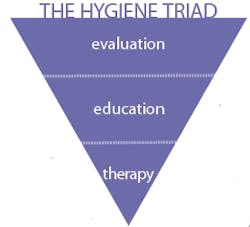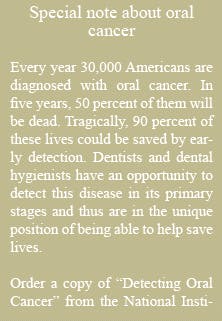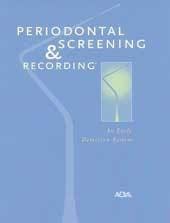by Linda Drevenstedt, RDH, MS
The “Hygiene Triad” format enhances the value of the hygiene appointment by shifting the hygienist’s focus from merely cleaning teeth to helping patients obtain ideal oral health. The highlight of the appointment is not the cleaning but the oral health evaluation and education.
▼ Evaluation
An evaluation of the patient’s current condition is completed at the beginning of each hygiene appointment.
The evaluation is a discovery process in which the patient is an active participant rather than a passive bystander who is told (or not told) the results of the examination. The elements of an evaluation are outlined below:
• Medical history update:
Ask these four critical questions:
- “Are you taking any different medications since your last visit?” If the patient already has a list of medications, ask the patient to review the list you have.
- “Have you been hospitalized since your last visit?”
- “Have you been diagnosed with any new conditions since your last visit?”
- “Do you have any problems or concerns?”
• Oral cancer screening
Four eyes are better than two! The oral cancer screening by the hygienist is an integral part of a thorough hygiene recall. The dentist completes the oral cancer examination and makes any diagnosis, but often this screening and exam are completed without the patient receiving communication about what is happening, why, and what the results are. Inform patients that you are conducting the National Institute of Health recommended oral cancer screening and that the examination covers 14 areas known to show early signs of oral cancer. If patients smoke, dip or chew tobacco, inform them that this habit places them at high risk for oral cancer. Stress that you will complete this screening at their recare appointment.
• Periodontal evaluation:
With the ADA, the media, oral health product advertising, and professional journals all acknowledging the link between oral and systemic health, there is no reason not to perform a periodontal screening at every adult hygiene appointment. Communicate the newest information to each patient and share a visual show-and-tell with a color-coded probe, walking the probe around all the teeth. Either record the exam in the PSR format or make notes about depths over three millimeters. Make sure the patient knows the periodontal examination results. Voice-activated charting makes this easy to accomplish.
Every adult patient should have a periodontal screening at the beginning of every recall appointment. This exam should not be left to incidental findings while cleaning; it is a formal procedure that the patient should expect at each recare appointment. The periodontal exam adds value to the recall appointment.
• Radiographs:
As appropriate for the patient’s condition.
• Intraoral camera:
The old saying “seeing is believing” is true, considering 80 percent of people learn visually. One of the most powerful tools dental hygienists can use to communicate with patients about their oral health is the intraoral camera. The specific intraoral pictures to capture are: those of treatment diagnosed but not completed, areas of patient concern, new findings from the exam, radiographs and a smile evaluation.
• Home care evaluation
▼ Education
Based on the findings in the evaluation phase of “The Hygiene Triad,” the personalized patient education is the focus of the communication between the hygienist and the patient during the hygiene appointment.
Shape each patient’s education time to reflect the findings of the preceding evaluation. Focus on restorative needs for the patient with a healthy periodontal evaluation but new or outstanding restorative needs. Focus on periodontal disease for the patient who has just been diagnosed with periodontal disease. For the perio education, keep it in simple terms: the etiology of gum disease, the role of bacteria in gum infection and bone destruction, and the sequence of appointments needed for treatment of their conditions. Also, emphasize the patient’s role as an active co-therapist and the need for evaluation and maintenance every three to four months to evaluate the healing process and home care and to detoxify the pockets.
The education phase can focus on coaching the patient on a personalized home-care program, such as daily oral infection control. Survey responses indicate that our adult patients do not like being told how to brush their teeth, and they particularly dislike being scolded or spoken to like young children. A hygienist in southern Georgia developed the following approach to coaching adult patients with dignity and respect:
“Ask patients to begin to think of their toothbrush as a tool that delivers medicine to areas of their gums that can harbor the bacteria and germs which cause gum disease. The medicine is placed on the soft toothbrush and the medicine is delivered into the crevice between the gum and the tooth. Using a jiggle motion the medicine is gently forced under the gum.”
Take time to allow the patient to practice and ask if you can coach them as they practice. Encourage patients to experiment with different brushes to find one they really like and learn to coach them on different brands of sonic or power brushes as well as some of the new varieties of manual toothbrushes.
Stop the floss insanity! Statistics reveal that only two percent of adults use dental floss. People buy yards of floss but most of it never leaves the drawer. Hygienists can recognize this neglect by all the stuff they find between patients’ teeth. Find alternatives to flossing and share them with your patients:
- Water Pik®, Hydro Floss or other interdental irrigators
- Stimudents®
- Rubber tips
- Proxabrush® or other interdental brushes
- Rota-dent
Think of the hygienist as a coach of the Plaque Control Olympics. Have the whole team try out different ways to clean interproximally without floss. Those who like flossing will keep flossing. Your patients will appreciate your open mind!
Communicate positive reinforcement: find something positive to affirm in each patient.
• What not to communicate:
Do not devalue recall. Recall appointments are not social visits and treating them as such devalues the time with the hygienist, nor is the hygiene appointment an opportunity to divulge personal information about your troubles or ailments, or your political or religious views. Using the recall appointment time for social conversation places the hygienist in the same category as the hair stylist in the patient’s mind. Those 45 or 60 minutes should center on speaking with the patient about his or her dental condition. Allow only a brief time to converse lightly with your patient for rapport. Remember that hygienists and dentists can add to the value of hygiene appointments through proper communication.
▼ Therapy
A complete prophylaxis, debridement or periodontal procedure - the therapy should reflect the patient’s previous evaluation.
Forget the notion that every patient must undergo a complete prophylaxis at a hygiene appointment, regardless of the evaluation findings. Too many hygienists complete a periodontal procedure, or a “Super Prophy,” at a recall appointment, charging it out as a prophy because no definitive evaluation determined the patient’s condition before the hygienist went to work to get the teeth clean.
• Brush up hygiene communication with a "Talk Over" exam:
In a “Talk Over,” the hygienist takes the evaluation data and talks it over with the dentist at the periodic exam. The “Talk Over” allows the hygienist to update the dentist on the patient’s condition while also reinforcing communication with the patient. Think of the “Talk Over” as the intern’s report on the patient’s condition to the physician during Grand Rounds at the hospital.
The hygienist reviews each part of the evaluation, including the medical history update, the oral cancer screening and the periodontal screening.
• Medical history update:
The hygienist tells the dentist any significant new information about the patient’s medical history. If no changes have occurred that must also be reported.
Example: “Dr. Dentist, Mrs. Patient now takes Lipitor® for her high cholesterol.”
• Oral cancer screening:
The hygienist reports any findings or suspicious areas.
Example: “Mrs. Patient’s oral cancer screening was within normal limits.”
• Periodontal evaluation:
The hygienist relays findings from the periodontal examination. The findings should be communicated using the PSR format or by noting individual areas over three millimeters. Healthy, normal results are also communicated.
Example: “Mrs. Patient falls within normal limits overall on her periodontal screening, but she has three areas over three millimeters. She showed four-millimeter readings with bleeding between 30 and 31, between 14 and 15 and between 2 and 3. Mrs. Patient knows that we will evaluate these areas at her next recare appointment, which I have recommended in three months instead of six. If the areas are still over three millimeters, we will need to schedule an appointment to treat the infection.”
• Radiographs:
The dentist often reviews X-rays behind the patient’s back on the view box or computer, but it is important to talk about the radiographs.
Find the booklet above (catalog no. 1206) at www.adacatalog.org or by calling (800) 947-4746
Example: “Dr. Dentist, I took four vertical films for Mrs. Patient; I would like you to review her bone level in those areas which were bleeding and to evaluate the large filling on tooth number 31.”
• Intraoral camera:
Employ a split-four picture on the screen for every patient. As the dentist enters the room for the periodic exam, you can point out the areas you chose to capture.
• Home care instructions and recommendations: As hygienists you should always review with the dentist what you have recommended and demonstrated to the patient. Nothing irks the patient more than to hear conflicting instructions from the hygienist and the dentist.
Example: “I coached Mrs. Patient on using a Rota-dent for those areas since she really dislikes dental floss. In conjunction with the Rota-dent, I recommended that she use PerioMed® as an infection control medicine once a day.”
• Restorative evaluation:
This is not a diagnosis; this is an evaluation of unhealthy areas. The hygienist must understand the dentist’s treatment philosophy to complete a restorative evaluation. Dentists, do not keep your dental hygienists in the dark! I want to share two quick personal asides on this subject:
First, as a hygienist who has worked as a temporary hygienist in many practices as I moved around, I can tell you that no two dentists look at the mouth the same way. An area to restore to one dentist is an area to watch for another. One dentist trusts in amalgam while another threw out the amalgamator years ago. One may repair a broken amalgam and another will crown the tooth. A dentist I did temp work for did not believe in sealants. My point: the dentist must take the responsibility of teaching each hygienist his/her treatment philosophy. When hygienists are aware of and confident with the dentist’s treatment philosophy, they can evaluate the patient’s complete oral health and communicate restorative procedures that may be appropriate for the patient’s condition.
Second, as a consultant I have interviewed hundreds of hygienists in practices. Many hygienists shy away from evaluating the patient’s mouth because they do not understand the dentist’s expectations and the dentist has never coached them in how he or she wants recommendations presented.
• Cosmetic/smile restorative evaluation:
Dentists must also educate hygienists on the growing cosmetic, implant and complex restorative dentistry. The dentist often attends multiple continuing education classes and has the ability to dramatically change the patient’s oral condition. However, without educating the hygienist about the newest procedures, methods and materials, the dentist is the lone ranger in presenting these possibilities to the patient. The dentist has the responsibility to communicate to the hygienists his vision for the ideal oral health of their patients and to carve out time to update the hygienists on any new procedures.
Example: “As Mrs. Patient and I discussed her smile today, she indicated an interest in whiter teeth. I told her that, with her stained filling, veneers that cover the entire tooth and create a smooth smile line might work best.”
Example: “I used the picture on the screen to show Mrs. Patient her stained fillings. I have shown her several sample photographs of patients who have had Lumineers®.”
“The Hygiene Triad” offers hygienists a thorough format for communication with patients and dentists alike.Linda Drevenstedt, RDH, MS, president of Drevenstedt Consulting, LLC, has developed a process to assist dental practices in reaching their potential. A practice-management consultant for more than 20 years, she has published in professional journals, and lectures at major conferences annually. Contact her at (800) 242-7648, at [email protected], or visit www.drevenstedt.com.









